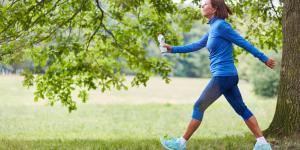Lipedema - Causes, Symptoms and Treatment


Lipedema is a pathology related to the production of excess adipose tissue which occurs almost exclusively in women. It is a little-known disease, but it can seriously affect the quality of life of those affected. Although it may be associated with obesity, it is a different condition and it can also affect slim people. Unfortunately, the cause of lipedema is relatively unknown. We do know there are both hormonal and genetic factors in developing this condition, although the exact nature of these factors is poorly understood.
At oneHOWTO, we help shed some light on a poorly understood medical condition by finding out the causes, symptoms and treatment of lipedema. We also discover what might be done to prevent lipedema.
What is lipedema?
Lipedema refers to a pathology of fatty adipose tissue that is exposed as a progressive pathological accumulation of fat cells. It occurs especially in the legs, although it can affect the arms when it has sufficiently progressed.
One of the main consequences of this disease is the increase in the volume of the legs or other affected areas. There are still no official data on the percentage of the world's population affected by lipedema, but it is estimated that between 10% and 20% of women on the planet suffer from this pathology[1].
Prevention of lipedema is essential. one of the main problems in lipedema development is misdiagnosis. Especially if the affected person is obese, lipedema can be misdiagnosed as this problem. Lipedema can also be erroneously thought to be other problems associated with the development of fat tissue. They include the following:
- Obesity
- Lymphedema
- Venostasis (slowed blood flow)
These problems can present similar symptoms to lipedema, but they are not the same. Another issue is that lipedema can co-exist with other conditions and further complicate the potential diagnosis. All too often, women are told by doctors that a sedentary lifestyle or poor diet are the reason for excess adipose tissue when the problem may actually be due to lipedema[2].
The origin of lipedema is not well defined, but the existence of a genetic component and a hormonal component has been detected. These factors increase the chances of its appearance. It commonly begins or intensifies when coinciding with a substantial change in hormone levels. This can include pregnancy, puberty, taking the birth control pill or menopause.
Although lipedema isn't caused by lifestyle, it can be a factor in its progression. Our guide to slimming the legs might help slow its trajectory.

Symptoms of lipedema
There is a very basic distinction between obesity and lipedema. In the clinical picture of lipedema, the build up of adipose tissue begins exclusively in the legs. If someone is overweight due to lifestyle and diet, the weight will collect in other areas of the body also. It is possible someone with lipedema can put on weight at the same time, but even in this case, the weight buildup will be disproportionately greater in the legs.
To detect lipedema early, you should pay close attention to the following symptoms :
- Itching of the legs without visible skin lesions
- Constant pain and a greater feeling of heaviness
- Accumulation of fat volume above the ankle area
- Increased volume and sensitivity upon contact with the affected area
- Feeling a lot of pressure in the calves
- Appearance of bruises
The adipose cells in the legs and arms progressively increase in size, giving a specific distribution of fat. The main characteristic of lipedema is a disproportion of volume in the legs or arms, with a large accumulation of fat, compared to the rest of the body.
Does lipedema hurt?
Lipedema can cause pain and discomfort in affected individuals. Lipedema is a chronic condition characterized by the abnormal accumulation of fat, typically in the lower extremities, such as the legs and thighs. The pain associated with lipedema can vary in intensity and type but is often described as having the following sensations:
- Tenderness
- Aching
- Sensitivity
- Heaviness
- Swelling
It's important to note that the pain associated with lipedema can have a significant impact on a person's quality of life, leading to reduced mobility and physical activity. Additionally, the condition can result in psychological distress due to changes in body appearance. For this reason, anxiety and depression are common symptoms of lipedema. These are both due to the physical issues created by lipedema and the mental problems related to body image and social exclusion.
Treatment of lipedema
There is no known cure for lipedema. Lipedema is a chronic condition characterized by the abnormal accumulation of fat in specific areas of the body, typically the legs and thighs. While there is no cure, there are various treatment options aimed at managing the symptoms and improving the quality of life for individuals with lipedema. These treatment approaches may include:
- Conservative management: lifestyle modifications such as maintaining a healthy weight, engaging in regular low-impact exercise and wearing compression garments can help manage symptoms and prevent progression.
- Manual lymphatic drainage (MLD): this specialized massage technique can help reduce swelling and improve lymphatic flow in the affected areas.
- Compression therapy: wearing compression garments, such as compression stockings or sleeves, can help reduce swelling and alleviate discomfort.
- Decongestive therapy: this comprehensive approach combines MLD, compression therapy, skin care and exercise to manage symptoms.
- Liposuction: in some cases, liposuction may be considered as a surgical option to remove excess fat and improve the appearance of affected areas. However, liposuction is not a cure and it may not be appropriate for all individuals with lipedema. It can also damage lymphatic vessels which leads to other complications.
- Medications: some medications may be prescribed to manage pain or inflammation associated with lipedema.
It's essential for individuals with lipedema to work closely with healthcare professionals, including lymphedema therapists and plastic surgeons. They will help you to develop a personalized treatment plan tailored to their specific needs and symptoms. The goal of treatment is to alleviate pain, reduce swelling and improve overall function and wellbeing.

How to prevent lipedema
Lipedema is believed to have a genetic component and it often runs in families. However, not everyone with a family history of lipedema will necessarily develop the condition.
If you have a family history of lipedema and are concerned about your risk, it's essential to be proactive in monitoring your health and seeking medical advice if you notice any symptoms or changes in your body. While there isn't a specific genetic test for lipedema, a medical evaluation by a healthcare professional can help assess your risk and provide guidance on symptom management and early intervention if necessary.
Here are some steps you can consider:
- Stay informed: learn about the signs and symptoms of lipedema so that you can recognize any early changes in your body.
- Maintain a healthy lifestyle: maintain a healthy weight through regular exercise and a balanced diet, as obesity is known to exacerbate lipedema symptoms.
- Regular check-ups: schedule regular check-ups with a healthcare provider to monitor your overall health and discuss any concerns or changes in your body.
- Seek medical advice: if you suspect you may have lipedema or notice symptoms such as pain, swelling, or changes in the distribution of body fat, consult a healthcare professional for a proper evaluation and diagnosis.
- Consult a genetic counselor: while there isn't a specific genetic test for lipedema, you can consult a genetic counselor to discuss your family history and potential genetic risk factors.
It's important to note that research on lipedema is ongoing. There may be advancements in understanding and managing the condition. Staying informed and seeking medical advice when needed are essential steps in managing your health if you have a family history of lipedema.
This article is merely informative, oneHOWTO does not have the authority to prescribe any medical treatments or create a diagnosis. We invite you to visit your doctor if you have any type of condition or pain.
If you want to read similar articles to Lipedema - Causes, Symptoms and Treatment, we recommend you visit our Diseases & secondary effects category.
2. Buck, D. W., 2nd, & Herbst, K. L. (2016). Lipedema: A Relatively Common Disease with Extremely Common Misconceptions. Plastic and reconstructive surgery. Global open, 4(9), e1043. https://doi.org/10.1097/GOX.0000000000001043






